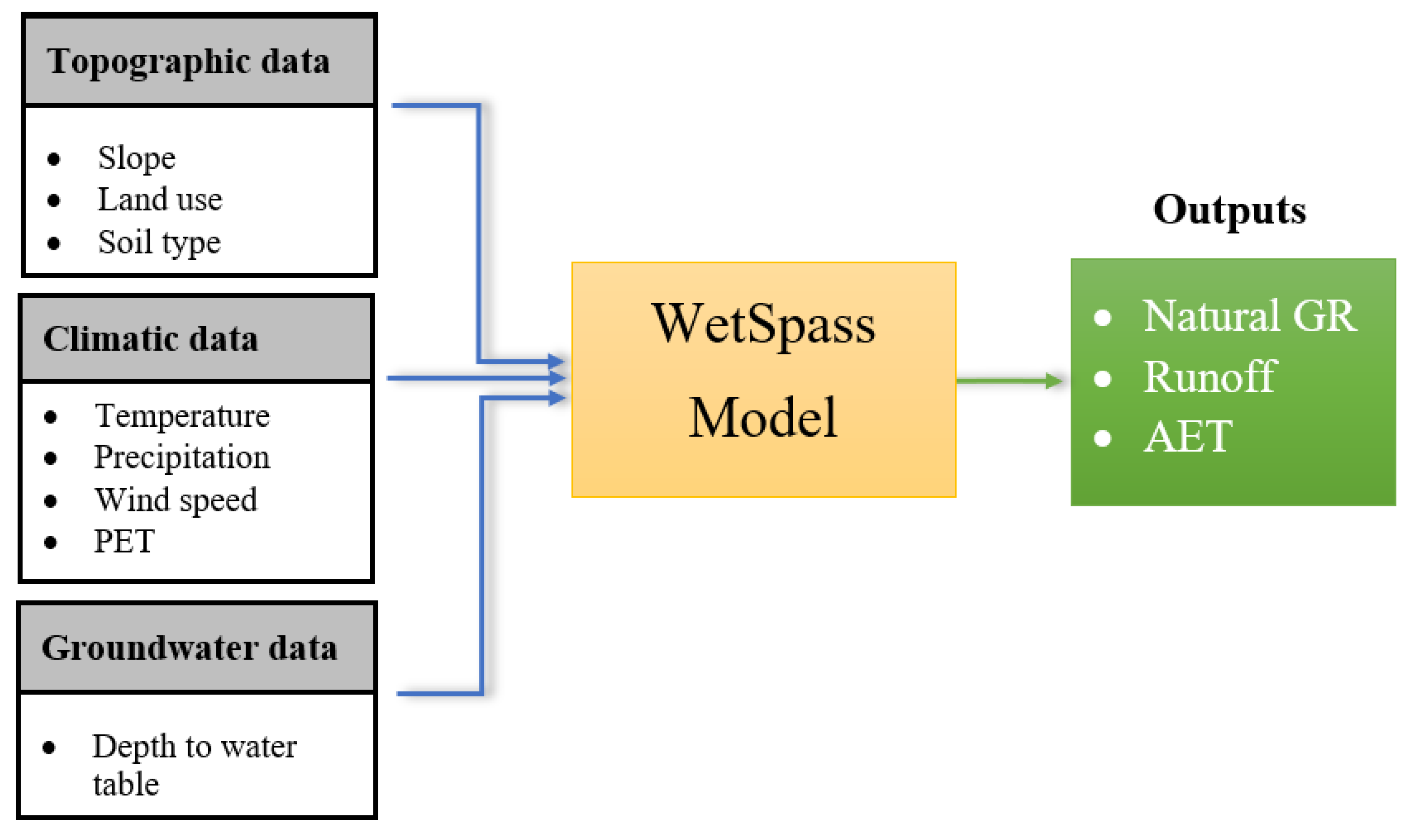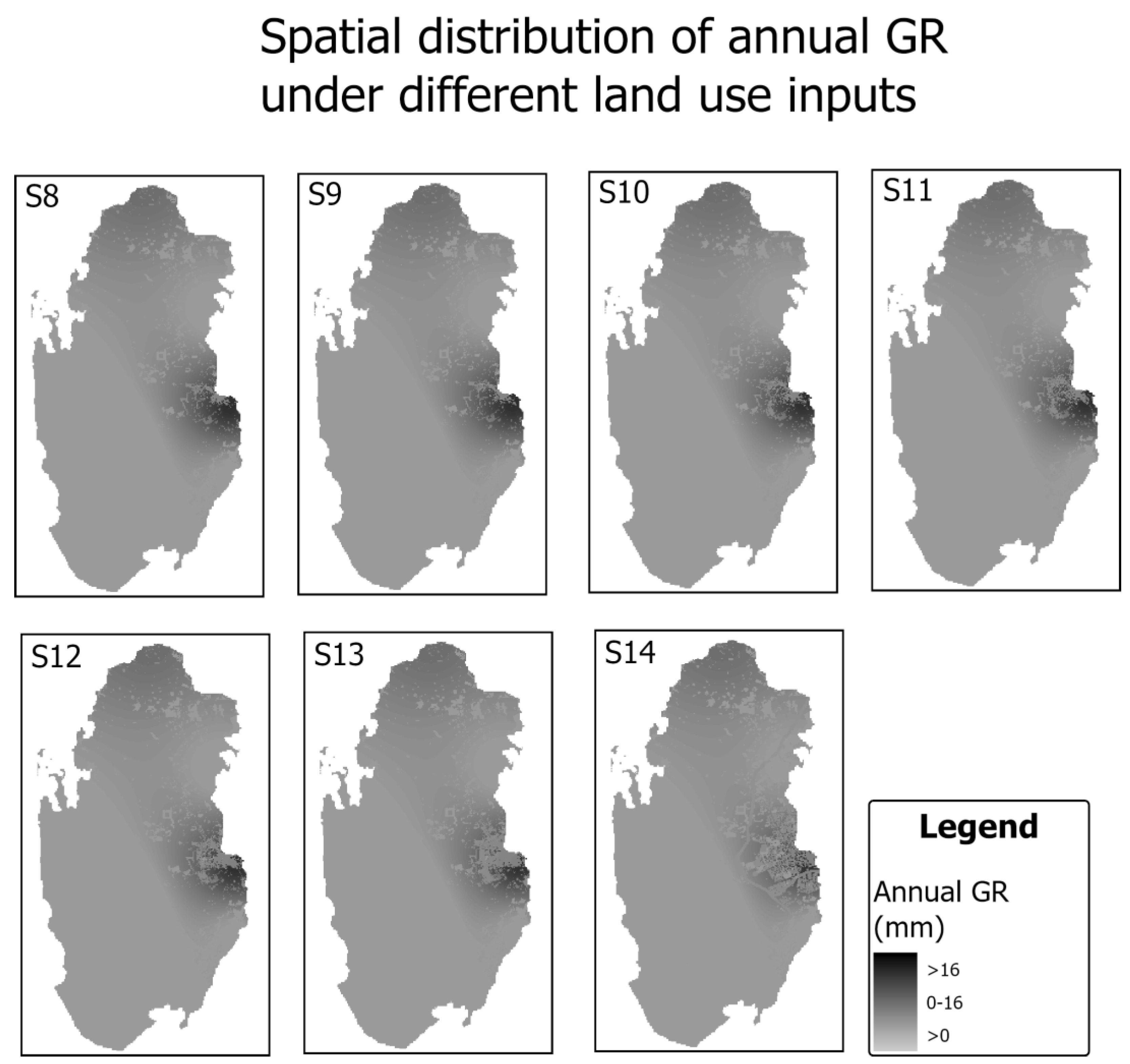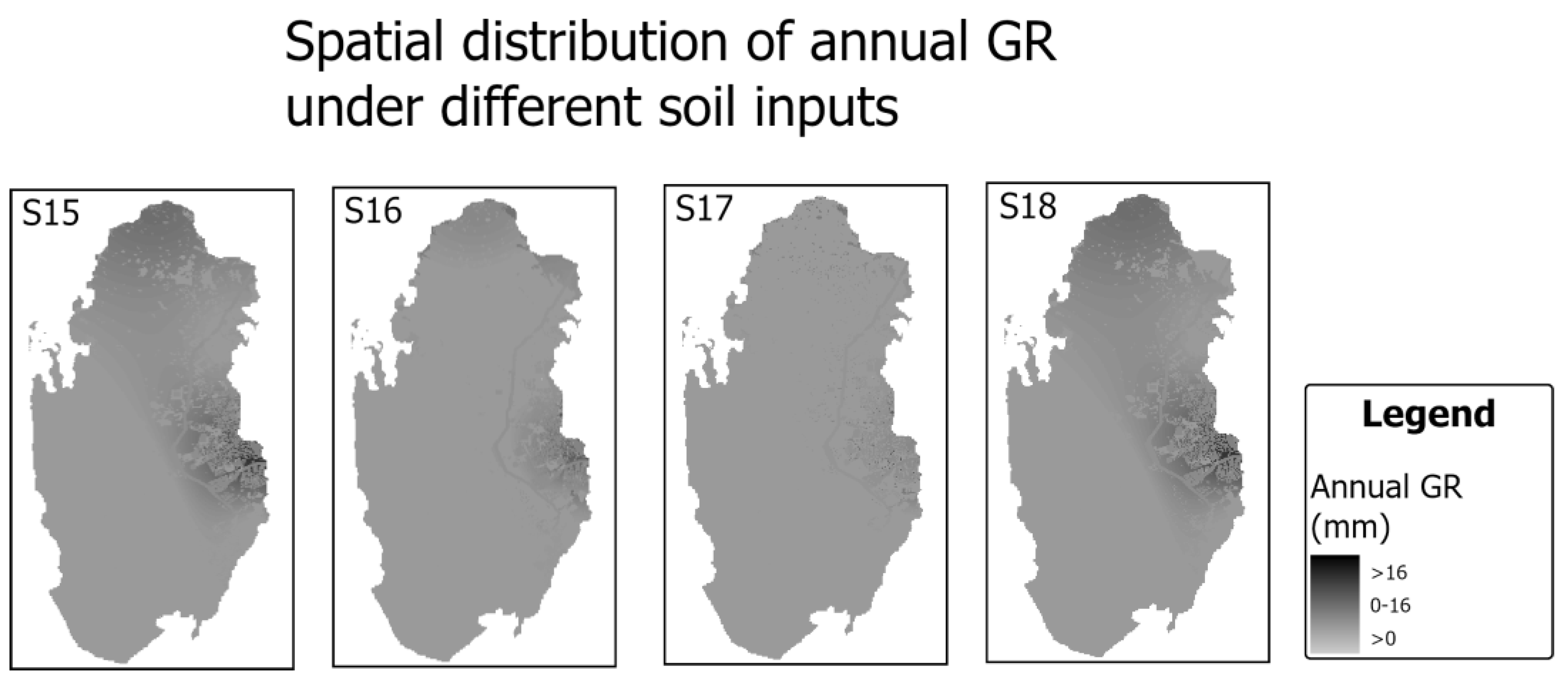Sensitivity of Groundwater Recharge Assessment to Input Data in Arid Areas
Abstract
1. Introduction
1.1. Case Study
2. Data and Methods
WetSpass
3. Methods
4. Results
4.1. GR Variations Due to Changes in Input Parameters
4.2. Correlation Analysis
5. Summary and Discussion
6. Conclusions
Author Contributions
Funding
Data Availability Statement
Conflicts of Interest
References
- Abotalib, A.Z.; Heggy, E. Groundwater mounding in fractured fossil aquifers in the Saharan-Arabian desert. In CAJG 2018: Advances in Sustainable and Environmental Hydrology, Hydrogeology, Hydrochemistry and Water Resources; Chaminé, H.I., Barbieri, M., Kisi, O., Chen, M., Merkel, B.J., Eds.; Advances in Science, Technology & Innovation (IEREK Interdisciplinary Series for Sustainable Development); Springer: Cham, Switzerland, 2019; pp. 359–362. [Google Scholar]
- Ajjur, S.B.; Al-Ghamdi, S.G. Is managed aquifer recharge a feasible solution for groundwater deterioration in Qatar? In Proceedings of the World Environmental and Water Resources Congress, Atlanta, GA, USA, 5–8 June 2022; pp. 168–175. [Google Scholar] [CrossRef]
- Zomlot, Z.; Verbeiren, B.; Huysmans, M.; Batelaan, O. Spatial distribution of groundwater recharge and base flow: Assessment of controlling factors. J. Hydrol. Reg. Stud. 2015, 4, 349–368. [Google Scholar] [CrossRef]
- Batelaan, O.; De Smedt, F. GIS-based recharge estimation by coupling surface–subsurface water balances. J. Hydrol. 2007, 337, 337–355. [Google Scholar] [CrossRef]
- Yenehun, A.; Dessie, M.; Nigate, F.; Belay, A.S.; Azeze, M.; Van Camp, M.; Fenetie Taye, D.; Kidane, D.; Adgo, E.; Nyssen, J.; et al. Spatial and temporal simulation of groundwater recharge and cross-validation with point measurements in volcanic aquifers with variable topography. Hydrol. Earth Syst. Sci. Discuss. 2021, 2021, 1–37. [Google Scholar] [CrossRef]
- Zhang, Y.; Liu, S.; Cheng, F.; Shen, Z. WetSpass-Based Study of the Effects of Urbanization on the Water Balance Components at Regional and Quadrat Scales in Beijing, China. Water 2018, 10, 5. [Google Scholar] [CrossRef]
- Ajjur, S.B.; Al-Ghamdi, S.G. Assessment of the Climate Change Impact on the Arabian Peninsula Evapotranspiration Losses. In Proceedings of the World Environmental and Water Resources Congress 2022, Atlanta, Georgia, USA, 5–8 June 2022. [Google Scholar]
- Wang, P.; Yu, J.; Pozdniakov, S.P.; Grinevsky, S.O.; Liu, C. Shallow groundwater dynamics and its driving forces in extremely arid areas: A case study of the lower Heihe River in northwestern China. Hydrol. Process. 2014, 28, 1539–1553. [Google Scholar] [CrossRef]
- López Valencia, O.M.; Johansen, K.; Aragón Solorio, B.J.L.; Li, T.; Houborg, R.; Malbeteau, Y.; AlMashharawi, S.; Altaf, M.U.; Fallatah, E.M.; Dasari, H.P.; et al. Mapping groundwater abstractions from irrigated agriculture: Big data, inverse modeling, and a satellite–model fusion approach. Hydrol. Earth Syst. Sci. 2020, 24, 5251–5277. [Google Scholar] [CrossRef]
- Khaki, M.; Hoteit, I. Monitoring water storage decline over the Middle East. J. Hydrol. 2021, 603, 127166. [Google Scholar] [CrossRef]
- Mazzoni, A.; Heggy, E.; Scabbia, G. Forecasting water budget deficits and groundwater depletion in the main fossil aquifer systems in North Africa and the Arabian Peninsula. Glob. Environ. Chang. 2018, 53, 157–173. [Google Scholar] [CrossRef]
- UN-ESCWA (United Nations Economic and Social Commission for Western Asia); BGR (Bundesanstalt für Geowissenschaften und Rohstoffe). Inventory of Shared Water Resources in Western Asia; United Nations Economic and Social Commission for Western Asia: Beirut, Lebanon, 2013. [Google Scholar]
- Martos-Rosillo, S.; González-Ramón, A.; Jiménez-Gavilán, P.; Andreo, B.; Durán, J.J.; Mancera, E. Review on groundwater recharge in carbonate aquifers from SW Mediterranean (Betic Cordillera, S Spain). Environ. Earth Sci. 2015, 74, 7571–7581. [Google Scholar] [CrossRef]
- Jackson, C.R.; Meister, R.; Prudhomme, C. Modelling the effects of climate change and its uncertainty on UK Chalk groundwater resources from an ensemble of global climate model projections. J. Hydrol. 2011, 399, 12–28. [Google Scholar] [CrossRef]
- Kimrey, J. Proposed Artificial Recharge Studies in Northern Qatar. United States Department of the Interior Geological Survey. 1985. Available online: https://pubs.er.usgs.gov/publication/ofr85343 (accessed on 5 October 2023).
- Eccleston, B.L.; Pike, J.G.; Harhash, I. The Water Resources of Qatar and Their Development; Food and Agricultural Organization of the United Nations: Rome, Italy, 1981. [Google Scholar]
- Harhash, I.; Yousif, A. Groundwater Recharge Estimates for the Period 1972–1983; Department of Agricultural and Water Research, Ministry of Industry and Agriculture: Doha, Qatar, 1985. [Google Scholar]
- Baalousha, H.M.; Barth, N.; Ramasomanana, F.H.; Ahzi, S. Groundwater recharge estimation and its spatial distribution in arid regions using GIS: A case study from Qatar karst aquifer. Model. Earth Syst. Environ. 2018, 4, 1319–1329. [Google Scholar] [CrossRef]
- Qatar Planning and Statistics Authority. Water Statistics in the State of Qatar, 2017. 2018. Available online: https://www.psa.gov.qa/en/statistics/Statistical%20Releases/Environmental/Water/2017/Water-Statistics-2017-EN.pdf (accessed on 5 October 2023).
- Tahir, F.; Ajjur, S.B.; Serdar, M.Z.; Al-Humaiqani, M.; Kim, D.; Al-Thani, S.K.; Al-Ghamdi, S.G. Qatar Climate Change Conference 2021: A Platform for Addressing Key Climate Change Topics Facing Qatar and the World; Hamad bin Khalifa University Press (HBKU Press): Doha, Qatar, 2021. [Google Scholar] [CrossRef]
- Ajjur, S.B.; Al-Ghamdi, S.G. Quantifying the uncertainty in future groundwater recharge simulations from regional climate models. Hydrol. Process. 2022, 36, e14645. [Google Scholar] [CrossRef]
- Tuel, A.; Choi, Y.-W.; AlRukaibi, D.; Eltahir, E.A.B. Extreme storms in Southwest Asia (Northern Arabian Peninsula) under current and future climates. Clim. Dyn. 2021, 58, 1509–1524. [Google Scholar] [CrossRef]
- Ajjur, S.B.; Al-Ghamdi, S.G. Global Hotspots for Future Absolute Temperature Extremes from CMIP6 Models. Earth Space Sci. 2021, 8, e2021EA001817. [Google Scholar] [CrossRef]
- Ajjur, S.B.; Al-Ghamdi, S.G. Variation in Seasonal Precipitation over Gaza (Palestine) and Its Sensitivity to Teleconnection Patterns. Water 2021, 13, 667. [Google Scholar] [CrossRef]
- World Bank. Population and Urbanization Indicators. 2023. Available online: https://www.worldbank.org/ (accessed on 12 December 2023).
- Lambert, L.A.; Lee, J. Nudging greywater acceptability in a Muslim country: Comparisons of different greywater reuse framings in Qatar. Environ. Sci. Policy 2018, 89, 93–99. [Google Scholar] [CrossRef]
- Shandas, V.; Makido, Y.; Ferwati, S. Rapid Urban Growth and Land Use Patterns in Doha, Qatar: Opportunities for Sustainability? Eur. J. Sustain. Dev. Res. 2017, 1, 11. [Google Scholar] [CrossRef]
- Ajjur, S.B.; Al-Ghamdi, S.G.; Baalousha, H.M. Sustainable Development of Qatar Aquifers under Global Warming Impact. Int. J. Glob. Warm. 2021, 25, 323–338. [Google Scholar] [CrossRef]
- Hargreaves, G.H.; Samani, Z.A. Reference Crop Evapotranspiration from Temperature. Appl. Eng. Agric. 1985, 1, 96–99. [Google Scholar] [CrossRef]
- Allen, R.G.; Pereira, L.S.; Raes, D.; Smith, M. Crop Evapotranspiration—Guidelines for Computing Crop Water Requirements; FAO Irrigation and Drainage Paper 56; FAO: Rome, Italy, 1998; p. D05109. [Google Scholar]
- FloodList. Qatar Flash Floods after Years Worth of Rain in One Day. 2021. Available online: https://floodlist.com/?s=qatar&submit= (accessed on 5 October 2023).






| Station | X Coordinates | Y Coordinates |
|---|---|---|
| Doha Airport | 51°34′8″ E | 25°14′47″ N |
| Dukhan | 50°45′27″ E | 25°24′23″ N |
| Umm Said | 51°34′7″ E | 24°56′32″ N |
| Al Khor | 51°30′31″ E | 25°37′35″ N |
| Al Ruwais | 51°12′37″ E | 26°8′41″ N |
| Al Karannah | 51°2′9″ E | 25°0′25″ N |
| Scenarios | Climatic Maps | Land Use Maps | Soil Map |
|---|---|---|---|
| S1 | Average 1986–1990 | Land use 2020 | Soil 2020 |
| S2 | Average 1991–1995 | ||
| S3 | Average 1996–2000 | ||
| S4 | Average 2001–2005 | ||
| S5 | Average 2006–2010 | ||
| S6 | Average 2011–2015 | ||
| S7 | Average 2016–2020 | ||
| S8 | Average 2016–2020 | Land use 1990 | |
| S9 | Land use 1995 | ||
| S10 | Land use 2000 | ||
| S11 | Land use 2005 | ||
| S12 | Land use 2010 | ||
| S13 | Land use 2015 | ||
| S14 | Land use 2020 | ||
| S15 | Land use 2020 | Larger lithosols | |
| S16 | Larger agricultural areas | ||
| S17 | Larger sabkha | ||
| S18 | Larger sand |
Disclaimer/Publisher’s Note: The statements, opinions and data contained in all publications are solely those of the individual author(s) and contributor(s) and not of MDPI and/or the editor(s). MDPI and/or the editor(s) disclaim responsibility for any injury to people or property resulting from any ideas, methods, instructions or products referred to in the content. |
© 2024 by the authors. Licensee MDPI, Basel, Switzerland. This article is an open access article distributed under the terms and conditions of the Creative Commons Attribution (CC BY) license (https://creativecommons.org/licenses/by/4.0/).
Share and Cite
Ajjur, S.B.; Di Lorenzo, E. Sensitivity of Groundwater Recharge Assessment to Input Data in Arid Areas. Hydrology 2024, 11, 28. https://doi.org/10.3390/hydrology11020028
Ajjur SB, Di Lorenzo E. Sensitivity of Groundwater Recharge Assessment to Input Data in Arid Areas. Hydrology. 2024; 11(2):28. https://doi.org/10.3390/hydrology11020028
Chicago/Turabian StyleAjjur, Salah Basem, and Emanuele Di Lorenzo. 2024. "Sensitivity of Groundwater Recharge Assessment to Input Data in Arid Areas" Hydrology 11, no. 2: 28. https://doi.org/10.3390/hydrology11020028
APA StyleAjjur, S. B., & Di Lorenzo, E. (2024). Sensitivity of Groundwater Recharge Assessment to Input Data in Arid Areas. Hydrology, 11(2), 28. https://doi.org/10.3390/hydrology11020028







